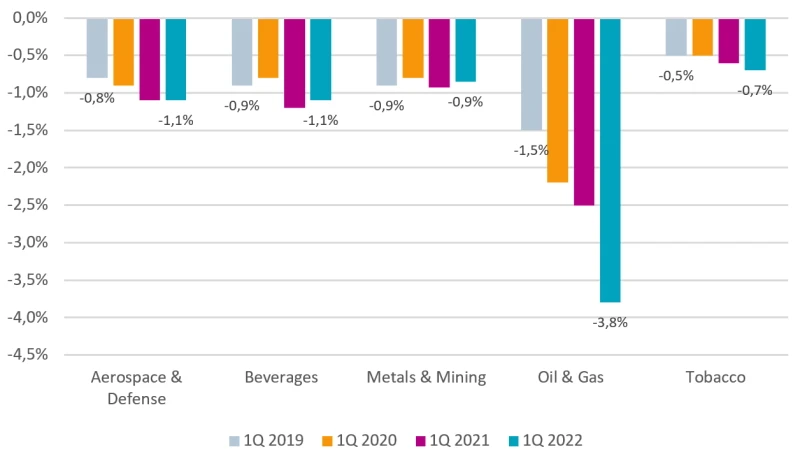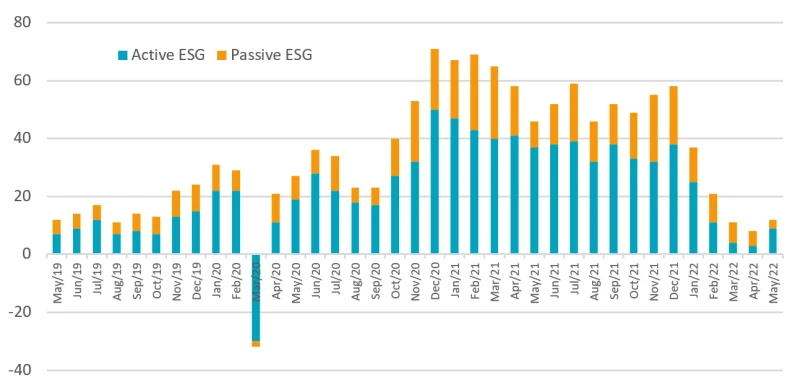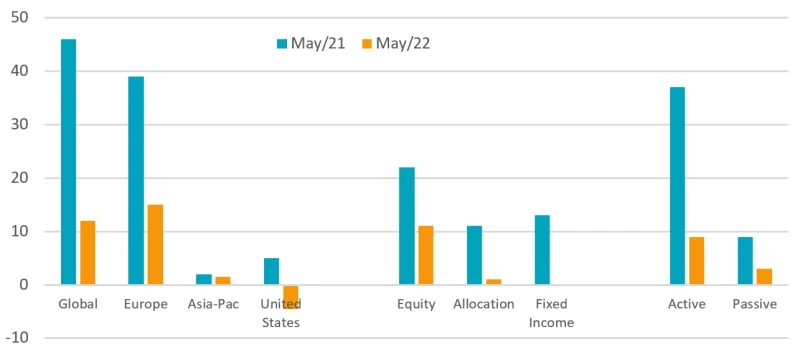Figure 1 depicts the underperformance of the headline MSCI ESG Leaders indices across the major developed market regions compared to the MSCI World market index year-to-date in 20221. Even though severe geopolitical tensions, spiking inflation and recessions fears have hurt global equity markets as a whole, the underperformance of sustainability indices has clearly been a trend change compared to previous years2.
MSCI ESG Leaders performance 2022 YTD

Source: Bloomberg. Data from 3 January to 20 June 2022. Returns are in EUR.
Market segments that have performed well, most notably fossil fuels, tobacco and defense, are commonly excluded by ESG investors, which probably explains a large part of today’s sustainability underperformance (Figures 2 and 3).
Excess performance vs. MSCI World (in EUR)

Source: Bloomberg, total return figures up 20 June 2022, in EUR.
Global ESG fund positioning in commonly excluded sectors

Source: Bernstein research, June 2022.
Recent weaker sustainability performance has without question once again sparked the debate around whether ‘doing good’ equals ‘losing money’, implying there is a natural trade-off between the two. Ideally, we want to create both wealth and well-being, but obviously sustainability strategies sometimes have competing priorities. Examples include climate concerns versus the social costs of high energy prices, or investing in defense companies during geopolitical turmoil.
The world does look different now
It is also clear that coming out of the Covid pandemic and with a war waging on the European continent, the world does look different this time – one in which sustainable investing has to evolve as well to better navigate increased market volatility.
As such, we could argue that sustainable investing is experiencing at least a ‘healthy’ reset in which mainstream assumptions about, for example, the effectiveness of strict exclusions but also ESG ratings are challenged. More sophisticated, practical approaches that apply more nuance and context will likely see increased market appetite.
The recent dwindling market appetite for sustainable investing clearly shows in fund flows too. While sustainability has been the standout story of fund flows in recent years, that trend has arguably weakened in recent months (Figure 4). For example, inflows into ESG funds stood at USD 13 billion in May 2022, which is an over 70% decline compared to the USD 46 billion from a year ago.
Global monthly ESG flows (USD billion)

Source: Morningstar, Morgan Stanley ESG research, June 2022.
Figure 5 shows a further breakdown of the drop in ESG flows across regions, asset classes and investment strategies. That said, for the first time since late 2021, inflows are ticking up again slightly, in particular for active European ESG equity strategies.
ESG fund flows by region, asset class and strategy (USD billion)

Source: Morningstar, Morgan Stanley ESG research, June 2022.
So where to go from here? Given that ESG has different colors and flavors, sustainable investing, too, is not defined in one particular way. In practice, asset owners and investors can choose the sustainability strategy most suitable to reaching their specific objectives, whether that is more impact-oriented, best-in-class ESG, exclusion-based, or more mainstream ESG integration, to name just a few. And even within each of those categories, there’s often room to maneuver in which sustainability objectives do not necessarily have to bite investment returns. The question is how?
緊貼荷寶可持續投資
獲取荷寶的電郵月報及最新觀點報告,構建最綠色的投資組合。
A barbell approach
In today’s market environment, fund managers’ fear of misaligned exposure and, conversely, desire to mitigate volatility from crowded ESG positions is high. As such, a better balance between growth and value is required. To that end, we favor an approach of owning quality companies at a reasonable price on one hand and value exposure on the other hand as an inflation hedge. In other words, owning quality businesses underpinned by strong sustainability strategies, while getting exposure to ESG improvers on the value end of the spectrum, gives flexibility whereby sustainability is not necessarily ‘sacrificing’ returns, or vice versa.
In the context of sustainable investing such a barbell approach is often referred to as “ESG integration,” something successfully explored by, for example, the Robeco Sustainable Global Stars Equities fund3. Core to this strategy is the integration of financially material ESG factors into the investment process.
In other words, sustainability that directly impacts the valuation of a company, i.e., by altering its growth outlook, profitability, risk profile or overall competitive positioning. In practice this means the strategy not only looks for high positive impact companies, but also invests in companies that are riskier as far as ESG is concerned– as long as this is also reflected in the financial model and thoroughly addressed with company management through engagement.
ESG performance attribution Sustainable Global Stars Equities

Source: Robeco research, 2022.
Sustainable investing has to evolve
Overall, every market environment brings new opportunities, also for sustainability investors. Within the wide range of sustainability strategies clearly some are more constrained than others, feeling the pain from sectors exclusions and factor exposures that until recently helped drive performance. Therefore, it becomes increasingly important to move sustainability beyond the stage of being a nice narrative alone and also stay valuation-disciplined by not overpaying for ‘good’; companies.
Going forward, we do not see the market appetite for sustainable investing suddenly disappearing. Despite seeing strong inflows for many years, still only a few percent of global assets under management are classified as ESG4, a number poised to go up over time given structural societal and regulatory support for sustainable investments5. Examples of the latter include the EU Taxonomy, a framework targeting environmentally sustainable activities, but also the EU’s more recent initiative to draft a Social Taxonomy, both of which are meant to re-direct and accelerate capital flows towards sustainable funds6. In short, despite weakening sentiment as of late, the structural underpinnings for sustainable investing still seem very much intact.
Today’s market environment, however, has taught us an important lesson; change is a constant. There is no free lunch – also sustainable investing has to advance to the next stage in its life cycle. Changing market dynamics demand a move away from simplistic, superficial sustainable approaches towards ones incorporating more forward-looking, nuanced insights and more thoughtful engagements. Ultimately, this should not only effect positive change with companies, but also make sustainable strategies more robust in navigating different, more complex market environments.
免責聲明
本文由荷宝海外投资基金管理(上海)有限公司(“荷宝上海”)编制, 本文内容仅供参考, 并不构成荷宝上海对任何人的购买或出售任何产品的建议、专业意见、要约、招揽或邀请。本文不应被视为对购买或出售任何投资产品的推荐或采用任何投资策略的建议。本文中的任何内容不得被视为有关法律、税务或投资方面的咨询, 也不表示任何投资或策略适合您的个人情况, 或以其他方式构成对您个人的推荐。 本文中所包含的信息和/或分析系根据荷宝上海所认为的可信渠道而获得的信息准备而成。荷宝上海不就其准确性、正确性、实用性或完整性作出任何陈述, 也不对因使用本文中的信息和/或分析而造成的损失承担任何责任。荷宝上海或其他任何关联机构及其董事、高级管理人员、员工均不对任何人因其依据本文所含信息而造成的任何直接或间接的损失或损害或任何其他后果承担责任或义务。 本文包含一些有关于未来业务、目标、管理纪律或其他方面的前瞻性陈述与预测, 这些陈述含有假设、风险和不确定性, 且是建立在截止到本文编写之日已有的信息之上。基于此, 我们不能保证这些前瞻性情况都会发生, 实际情况可能会与本文中的陈述具有一定的差别。我们不能保证本文中的统计信息在任何特定条件下都是准确、适当和完整的, 亦不能保证这些统计信息以及据以得出这些信息的假设能够反映荷宝上海可能遇到的市场条件或未来表现。本文中的信息是基于当前的市场情况, 这很有可能因随后的市场事件或其他原因而发生变化, 本文内容可能因此未反映最新情况,荷宝上海不负责更新本文, 或对本文中不准确或遗漏之信息进行纠正。

